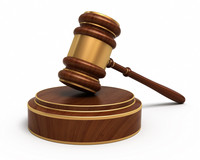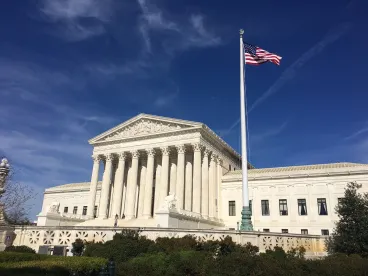Yesterday, in Thryv, Inc., f/k/a Dex Media, Inc. v. Click-To-Call Technologies, LP, et al., the U.S. Supreme Court ruled 7-2 that the non-appealability of Patent Trial and Appeal Board (PTAB) institution decisions encompasses PTAB decisions on whether a statutory time bar applies. More specifically, 35 U.S.C. §314(d), which sets forth the finality and nonappealability of decisions on the institution of an Inter Partes Review (IPR) proceeding “under this section,” includes decisions implicating the one-year time bar under 35 U.S.C. §315(b). The Supreme Court vacated the prior holding of the Court of Appeals for the Federal Circuit in Click-To-Call Techs., LP v. Ingenio, Inc.., 899 F.3d 1321 (Fed. Cir. 2018) (discussed in our prior blog post) and remanded this case to the Federal Circuit with instructions to dismiss for lack of appellate jurisdiction.
Background
This Supreme Court decision comes after a long procedural history, which goes back as far as 2001, when an earlier owner of the patent in suit sued a predecessor of the defendant in the pending litigation. The parties there stipulated to a voluntary dismissal without prejudice. Well after that litigation, a successor to the defendant filed an IPR in 2013, less than a year after the current patent owner, Click-to-Call Technologies, sued for patent infringement.
In a Final Written Decision dated October 28, 2014 (Oracle Corp. et al. v. Click-to-Call Technologies LP, No. IPR2013-00312 (Paper No. 52)), the PTAB invalidated some of the claims in the Click-to-Call patent. The PTAB also reaffirmed its original conclusion, presented in its Institution Decision, holding that “voluntary dismissal of a complaint without prejudice does not trigger a bar under § 315(b).” The PTAB relied on Federal Circuit precedent that voluntary dismissal leaves parties as though the litigation had never been filed. Consequently, the PTAB held that the petitioners here were not barred from filing an IPR petition.
The Federal Circuit disagreed, finding Click-To-Call’s petition time barred, and vacated the PTAB’s invalidity finding. The Federal Circuit relied on its finding in Wi-Fi One, LLC v. Broadcom Corp. that “the [USPTO] Director’s time-bar determinations under § 315(b) are not exempt from judicial review,” which overruled a “contrary conclusion” in Achates Reference Publ’g, Inc. v. Apple Inc. The Federal Circuit noted in Wi-Fi One, LLC that its “holding applie[d] only to the appealability of § 315(b) time-bar determinations” and not to “whether all disputes arising from §§ 311-14 are final and nonappealable.”
Thryv Inc. petitioned the Supreme Court successfully for certiorari, arguing inter alia that the Federal Circuit could not review the §315(b) time bar on appeal and that the Federal Circuit used a “narrow exception” in Cuozzo Speed Techs., LLC v. Lee (discussed in our prior blog posts) to “undercut Congress’s policy determination that institution decisions cannot be appealed.”
 The Decision
The Decision
In vacating the Federal Circuit’s instruction to dismiss the IPR proceeding, the Supreme Court held:
The [PTAB]’s application of §315(b)’s time limit… is closely related to its decision whether to institute inter partes review and is therefore rendered nonappealable by §314(d).
In reaching this conclusion, the Supreme Court relied on its prior holding in Cuozzo that §314(d) bars review at least of matters “closely tied to the application and interpretation of statutes related to” an IPR institution decision, and that “a §315(b) challenge easily meets that measurement.” The Court also noted that §315(b)’s “time limitation” was “integral” because it set forth circumstances in which “[a]n inter partes review may not be instituted.” The Court noted further that because §315(b) “expressly governs institution and nothing more,” a contention “that a petition fails” under this section is a contention that the PTAB should have refused to institute an inter partes review.
As further support for its conclusion, the Court explained that allowing §315(b) appeals would be contrary to the “purpose and design” of the AIA, noting that Congress “designed inter partes review to weed out bad patent claims efficiently.” It explained that allowing §315(b) appeals would
tug against that objective, wasting the resources spent resolving patentability and leaving bad patents enforceable [and also]… unwind agency proceedings determining patentability and leave bad patents enforceable.
The Court also explained that a contrary holding would provide “a patent owner” that “could not prevail on patentability” with the option to “appeal on §315(b) untimeliness grounds only,” and thus §315(b) “would operate to save bad patent claims.”
Relationship to Prior Interpretation
The Court noted that this opinion was consistent with its prior interpretation of the AIA in Cuozzo and in SAS Institute Inc. v. Iancu.
In its appeal, the patent owner Click-to-Call argued that “the bar on judicial review applies only to the agency’s threshold determination under §314(a) of the question whether the petitioner has a reasonable likelihood of prevailing.” In response, the Supreme Court explained that Cuozzo was fatal to Click-to-Call’s narrow interpretation of §314(d), because Cuozzo “held unreviewable the agency’s application of §312(a)(3)” and “explained that the bar extends to challenges grounded in ‘statutes related to’ the institution decision.” The Court also noted that
§314(d) refers not to a determination under subsection (a), but to the determination “under this section.” That phrase indicates that §314 governs the Director’s institution of inter partes review. Titled “Institution of inter partes review,” §314 is the section housing the command to the Director to “determine whether to institute an inter partes review,” §314(b). Thus, every decision to institute is made “under” §314 but must take account of specifications in other provisions.
The Dissent
Writing for the minority, Justice Gorsuch provided a different interpretation of §314(d) with respect to judicial review and noted that the majority
takes a flawed premise—that the Constitution permits a politically guided agency to revoke an inventor’s property right in an issued patent—and bends it further, allowing the agency’s decision to stand immune from judicial review. Worse, the Court closes the courthouse not in a case where the patent owner is merely unhappy with the merits of the agency’s decision but where the owner claims the agency’s proceedings were unlawful from the start. Most remarkably, the Court denies judicial review even though the government now concedes that the patent owner is right and this entire exercise in property taking-by-bureaucracy was forbidden by law…
The dissent also noted:
Nothing in §315(b) speaks of a “determination by the Director,” let alone suggests that the agency’s initial ruling on a petition’s timeliness is “final and nonappealable”… To pretend otherwise would invite a linguistic nonsense… To pretend otherwise would invite a practical nonsense as well. Because the Director’s initial “reasonable likelihood” determination under §314(a) relates to the merits, it will be effectively reviewed both by the Board and courts as the case progresses. But when does the Director’s application of §315(b)’s time bar get another look?
Conclusions
The Supreme Court’s decision expands the non-appealability of PTAB institution decisions even further than Cuozzo did, to encompass time-bar issues under §315(b).
The procedural history of this case is lengthy and complicated because of the changes in patent ownership and the changes in status of the various accused infringers. But it appears that the USPTO acknowledged that the PTAB’s institution decision was wrong: the earlier litigation should have served as a bar. Under the Supreme Court ruling, the correctness of the PTAB’s decision regarding the time-bar does not matter.
In the future, the PTAB is likely to be vigilant in assessing issues relating to prior litigations between predecessors. At the same time, the Supreme Court’s decision gives the PTAB authority to consider and implement time-bar issues without concern that an appellate court will vacate its decisions on the merits by finding that the IPR was time-barred and should not have been instituted. The PTAB may, as a result of this decision, be more inclined to institute an IPR in the face of issues relating to the time-bar.
For all these reasons, patent litigants should also be vigilant, especially in IPR proceedings. Patent owners should take care to account for prior litigation that could inadvertently create a future time-bar issue. Defendants who might otherwise agree to the voluntary dismissal of a complaint without prejudice should be aware that this may start the time-bar clock, and may want to insist on a covenant not to sue as part of a stipulated dismissal.





 />i
/>i
